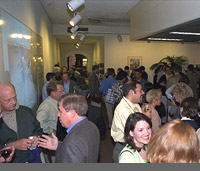| |
Pub Talk
"High-Volume Web Site Performance
Simulator For WebSphere"
THURSDAY, MARCH 14, 2002
By Mr. Noshir C. Wadia
Senior Technical Staff Member
High-Volume Web Sites, Software Group
IBM Corporation
Open to the Public. No fee. 5:00 - 7:00 p.m.
The Pub Talk begins at 6:00 p.m.
As eBusiness and its related requirements grow at "Web speed,"
a critical issue is whether the IT infrastructure supporting the
Web sites has what it needs to provide available, scalable, fast,
and efficient access to the company's information, products, and
services. More than ever, CIOs and their teams struggle with the
challenges to minimize downtime and bottlenecks and maximize the
use of the hardware and software that comprises their eBusiness
infrastructure. Configuration planning for large Web servers in
this environment is becoming an increasingly difficult task. The
hardware and software structure of large Web sites is becoming complex
and the behavior characteristics of the workloads are at best poorly
understood, or, at worst essentially unknown because the workload
has yet to be implemented.
The infrastructure supporting most high-volume Web sites (HVWSs)
typically has multiple components, which include clients, the network,
and multiple layers of machines within the Web server. These multiple
machine layers are frequently called tiers with each tier handling
a particular set of functions, such as serving content, providing
integration business environments, or processing data base transactions.
While actual customer implementations can vary widely, the simulator
uses the following generalized view of the infrastructure options.
IBM Patterns for eBusiness & Workloads: These are built in workloads
for the major business patterns: shopping, trading, and banking.
The user can use these pre-built workloads or modify them based
on customer's requirements. Users can also define a very specific
workload if pre-built workloads do not fit customer environments.
We have also developed special algorithms to handle bursty web traffic,
which can occur during holiday season or stock market storm. User
can define the degree of burstiness in the terms of burst/peak ratio.
The user can set a specific performance objective for items such
as (1) user visit rate, (2) resource utilization, (3) response time,
(4) # of concurrent users, and (5) page view rate. The model will
estimate the performance and recommend configurations.
ABOUT NOSHIR C. WADIA
Noshir C. Wadia is a Senior
Technical Staff Member in the High-Volume Web Sites organization
of IBM's Software Group. He is currently leading a team to develop
simulator for performance/capacity estimates. He is also working
with large IBM customers on web site performance issues. Mr. Wadia
has held many leadership positions in architecture/performance throughout
his IBM career developing performance/architecture models for parallel
and distributed systems. Mr. Wadia has been author of many papers
in the area of performance. He has also been adjunct professor for
ten years at State University of New York where he taught Computer
Systems Architecture and Design. Mr. Wadia holds a MS in Computer
Science from Syracuse University, a MS from Applied Statistics from
Purdue University, and a MS in Mathematical Statistics from University
of Baroda (India).
|
